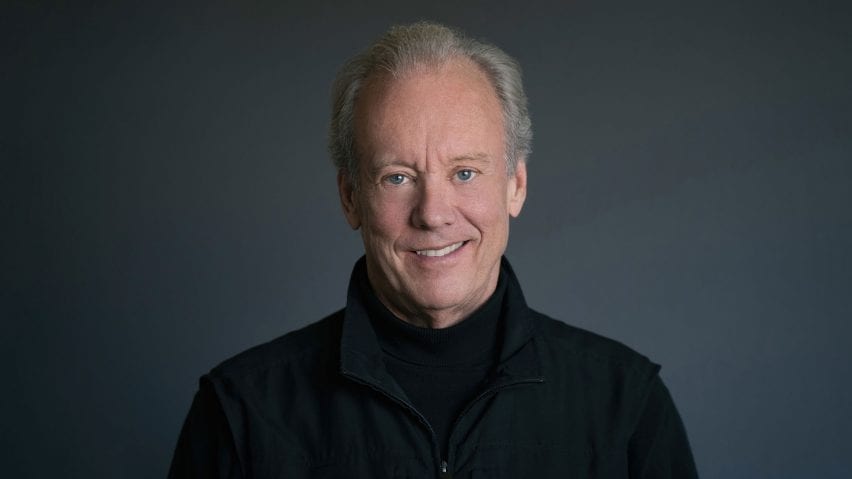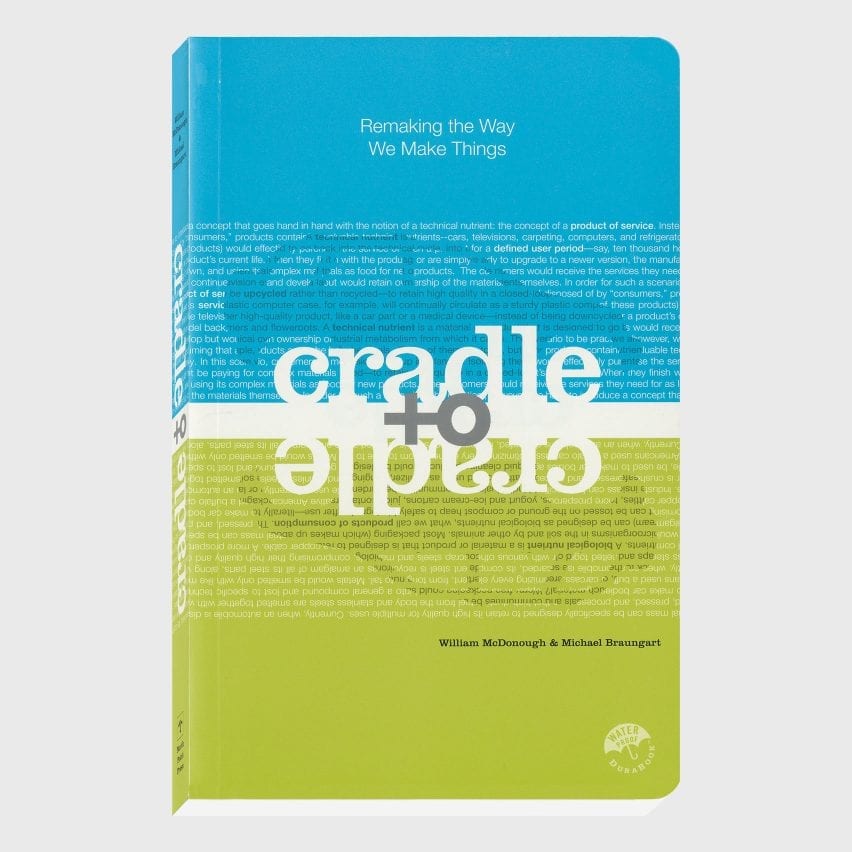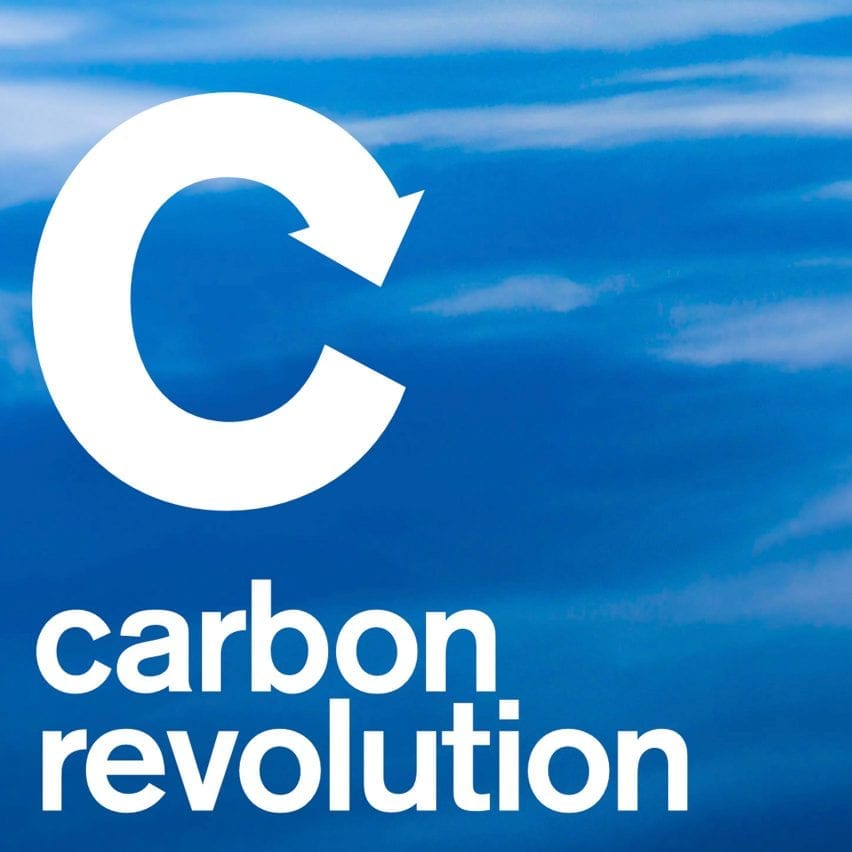
Climate change is "a design project needing lots of attention" says William McDonough
Removing excess carbon from the atmosphere is a daunting but "very exciting" design challenge, according to sustainable-design guru William McDonough.
Describing climate change as a "design failure," the American architect and designer said that solving it will involve "hundreds of technologies and systems."
"It's a design project needing lots of attention," McDonough told Dezeen via a video call from his home in Virginia. "It's very exciting to look at how many ways we can do this, but it's daunting".
The root of the problem is what McDonough describes as "fugitive carbon". This is anthropogenic carbon in the atmosphere that "meets the description of a toxin: it's the wrong material, wrong place, wrong dose, wrong duration."

The educator and writer, whose seminal 2002 book Cradle to Cradle is regarded as the precursor to the circular design movement, turned his attention to carbon in 2016 when he wrote a ground-breaking article for the science journal Nature.
"Climate change is the result of breakdowns in the carbon cycle caused by us," he wrote in the article, which was echoed in a speech given around the same time at the COP22 climate-change conference in Marrakech. "It is a design failure."
Carbon is "an innocent element in all this"
He further set out his thinking in a blog post that called for "a new language for carbon". This categorised carbon into three categories.
"Living carbon" moves through all living things in an endless cycle that makes life possible.
"Durable carbon" describes the earth's carbon stores, including fossil reserves, limestone and long-lasting materials such as timber and recyclable polymers.
"Fugitive carbon" is carbon that mankind has taken from the first two categories and put into the atmosphere. The twin design challenges are to stop creating more of it while bringing the rest of it back to earth.
"The point I wanted to make there was that we had started referring to carbon as the enemy," he explained. "Carbon is not our enemy. It's a friend. It's an innocent element in all this. I thought we needed a new language."
"We are probably going to have to electrify everything"
Creating this new taxonomy allowed McDonough to start seeing atmospheric carbon as a design problem that could be solved.
"I see encouraging living carbon as positive behaviour; doing carbon-neutral things as neutral behaviour; and releasing carbon where it doesn't as negative behaviour," he explained. "I tried to get the language straight enough so I can design with it."
One part of the solution is to simply "stop burning... let's not use the word fossil fuels," he said. "Because it means we intend to burn it."
Switching from fossil energy will involve "massive efficiency and massive adoption of renewables. We are probably going to have to electrify everything."
Hydrogen could be used for heavier uses such as long-distance trucking and heavy industry, he said. Carbon-free ammonia, which has a higher energy density than hydrogen and is less volatile, could power shipping.
McDonough warns about "the fallacy of the offset"
The other challenge is to remove fugitive carbon from the atmosphere. But this problem is hard to understand and solutions are hard to grasp, McDonough said, comparing it to an overflowing bathtub.
"You've got to go upstairs, turn off the faucet and pull the drain because even with these zero-carbon goals, even if we're emitting zero, we've still overloaded the atmosphere. We have to start removing."
This will involve "probably 20 or 30 different techniques" including yet-to-be-developed chemical solutions, mechanical solutions such as the direct air capture technology being developed by companies such as Climeworks, and natural solutions including soil sequestration, afforestation and rewilding.
"So let's plant mangroves, let's restore ecosystems everywhere we can, all over the planet, all the time." However, he warned about a paradigm he describes as "the fallacy of the offset".
Offsetting is a way of compensating for carbon emissions by paying for carbon mitigation elsewhere. To work, the offsetting investment has to actively remove carbon from the atmosphere, but it is often used as an accounting trick to justify emitting more carbon.
"I call it the fallacy of the offset," he explained. "You gotta watch out for it. If somebody says, oh, I've got this much renewable power and I'm gonna offset my carbon emissions, you have to be very careful."
"That would logically then say that if you doubled your renewables, you could double your carbon and still be net-zero. That doesn't make any sense at all, because the atmosphere absorbs twice as much carbon."
"So we got to be very careful about false equivalence. Renewables don't equal to [removing] carbon."
McDonough has been called "the father of the circular economy"
Born in Japan in 1951, McDonough is based in Charlottesville, Virginia, where he runs his architectural practice William McDonough + Partners and McDonough Innovation, a consultancy advising corporations and governments on their sustainability strategies.
He has advised bodies including the World Economic Forum and the G20 on sustainability. With actor Brad Pitt he co-founded the Make It Right Foundation, which was founded to rebuild the hurricane-devastated Lower 9th Ward in New Orleans.
In design circles, he is best known as the co-author of Cradle to Cradle: Remaking the Way We Make Things, which he wrote with chemist Michael Braungart. The landmark publication called for a new design approach that learns from natural systems and eliminates waste.
"I've been called the father of the circular economy," he remarked. "Cradle to Cradle actually leads into the circular economy, if you think about it."
Humanity will need to adopt principles of circularity
To stop climate change, humanity will have to adapt the principles of circularity in order to capture fugitive carbon. McDonough describes the goal as the "circular carbon economy".
This will involve "moving toward recyclates," McDonough said, referring to materials that are capable of being recycled many times. "There's going to be a big move to do chemical recycling of plastics to get them back to oil basically and start over. Plastics are an immensely useful thing, but not if they go fugitive."
Biomaterials such as agricultural byproducts, bacteria and mycelium have huge potential too since they store large amounts of carbon.
"We've been working with mycelium for many years," McDonough said. "They have amazing properties. They can be insulation, packaging, various kinds of acoustic material. They can be grown in a factory on agricultural secondaries such as wheat straw or barley straw."
"Then with bacteria, we can actually make bricks. You're building coral reef, basically. It's room-temperature manufacturing. It's quite astonishing. Those things are coming."
However, using large amounts of land to grow crops for biomaterials runs the risk of creating monocultures that damage biodiversity.
"When you're looking at it just through a utilitarian lens, we can see certain materials are quite astonishing in performance," he said. "But a balance of utility and ecological restoration has always got to be considered in these issues."

The ultimate biomaterial is, of course, wood.
"I think it's fundamental and it's hugely important," he said. "It's critical because we need living wood in order to sequester carbon from the atmosphere. We need nature-based solutions to carbon in the atmosphere. And trees play a huge role in that."
Mass-timber buildings are "coming very fast"
The use of timber as a construction material is "coming very fast," he said, with cross-laminated timber, in particular, allowing architects to build high-performance mass-timber buildings, including tall structures.
William McDonough + Partners' Apex Plaza headquarters for Apex Clean Energy, under construction in Charlottesville, will be the tallest timber building on America's eastern seaboard when it completes later this year.
The eight-storey CLT structure will have "a total potential carbon benefit of approximately 3,000 metric tonnes compared to traditional approaches," according to William McDonough + Partners' website.
Wood "holds up very well in fire too," he explains. "Some people are surprised by that but wood will char before steel fails. High temperatures can take steel down long before a wood structure."
Just ten per cent of waste wood is estimated to be recycled
However, cutting down trees to make products including furniture and paper is a potentially wasteful use of wood, McDonough argues. "Just think about carving wood. It's a negative process, right? We're cutting away stuff all the time."
An estimated 15 billion trees are cut down each year for their timber but a substantial percentage of this is wasted. Timber accounted for over eight per cent of all landfilled municipal waste in the USA in 2018, and over eight per cent of all incinerated waste.
It is estimated that just ten per cent of waste wood is recycled, with the rest burned or sent to landfill, meaning all the carbon contained in the timber is returned to the atmosphere.
Paper production is another poor use of wood, McDonough believes. "I think we can look for other sources of fibre. Using something as beautiful as a tree to make a newspaper is a bit silly. The New York Times Sunday edition took five square miles of clear cuts. Just the Sunday version!"
Secondary agricultural materials including straw, which is usually burned, are better potential sources of paper fibre, he argued.
McDonough is particularly excited about new techniques for 3D printing with wood waste. "They've discovered how to 3D print with wood," he explained, referring to a technique developed by Californian company Forust.
This takes waste sawdust and lignin, a natural polymer found in wood that is a byproduct of the paper industry, and "rematerialises" it as a printable material. "It could save a lot of trees," McDonough said. "It's kind of fun and it's quite beautiful."
McDonough's grandfather was a lumberjack who worked in the great forests of the Pacific Northwest. As a result, he has "a lot of big tree karma". He talks poetically about forests, remarking that "every tree is precious, every tree is a treasure, every tree is a carbon-capturing engine."
However, the belief that simply planting more trees can solve the climate crisis is simplistic, he agrees. There is growing concern that forests are not secure enough to serve as long-term carbon stores since once they have been planted, the trees could die and rot or burn, or their timber could be put to short-term use.
In either case, the carbon goes straight back into the atmosphere. "What happens next? That is the question. You're betting on a future you hope you can control. It is tricky business."
Forests are "essential to culture"
But there are plenty of other reasons why forests are essential, he points out, including protecting biodiversity, conserving water and preventing erosion.
"I think taking care of forests is something that is essential to culture," he argued. "There are so many reasons to do it beyond carbon sequestration. It's still worth doing even if the carbon equations are skewed a bit because it's about a 25-year cycle. The tree grows, dies, becomes carbon, goes up, comes back."
"So how do we love the tree?" he concludes. "We don't love it by cutting it down. It's not just a resource. We love it by nurturing it."
But surely trees do need to be cut down if the products made from them are going to serve as long-term carbon stores and help replace materials that generate fugitive carbon?
"It's the same as eating food," he responds. "You bless it. it blesses you. So you do have a relationship."
The portrait used at the top of this story is by Duhon Photography.

Carbon revolution
This article is part of Dezeen's carbon revolution series, which explores how this miracle material could be removed from the atmosphere and put to use on earth. Read all the content at: www.dezeen.com/carbon.
The sky photograph used in the carbon revolution graphic is by Taylor van Riper via Unsplash.